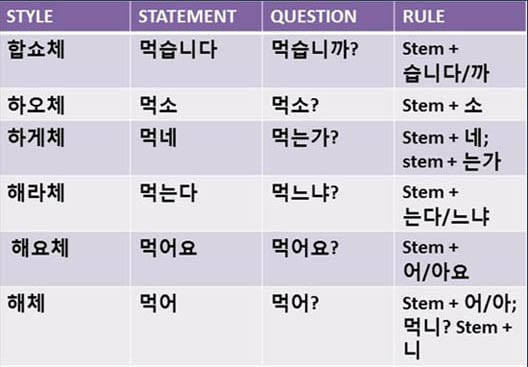When you’re learning Korean, you will be introduced to different Korean speech levels. Each Korean speech level is used to express a certain amount of respect or courtesy to the person or group you’re addressing. Learn the different levels of speech with Korean teacher Bryce J….
What Are Korean Speech Levels?
Korean speech levels are used to show respect and there is a certain order to how they are used like honorifics. If Korean speech levels are not used or used improperly, they can result in embarrassment or humiliation.
Korean speech levels can also insult the person that is being spoken to as there is a certain order to obey and follow when speaking to elders. Not giving the proper respect when with the correct Korean speech levels can certainly offend someone and is an important part of the Korean language and culture.
Understanding Korean Speech Levels
Fundamentally, parts of Korean speech are formed by stringing together smaller units to create words and phrases. This idea is seen in many languages, including English.
To illustrate this, let’s look at the word needlessly. The core competent of the word is need. This part of the word can be used independently, as in I need something to eat. The second part of the word, less, can be used independently; less work, more play, but it can also used to enhance the meaning of core words, like helpless, homeless, and needless. Finally, the end of the word, ly, cannot be used independently. This piece is attached to the end of a verb to create an adverb as in sadly, truthfully, and excitedly.
The most basic parts of the Korean language usually consist of at least one word that, when found in a dictionary, ends in -다 . Both verbs and adjectives end in -다 in Korean, and for our current purpose, they behave similarly. To correctly form a Korean statement, we need to remove the -다 and add another unit of meaning.
For example, look at the statement 좋았겠네요. The core of the word structure is 좋 which appears in the dictionary as 좋다, and means good, fine, nice, better, superior. The next unit is 았, which signifies past tense or a completed action or state. 겠 means the statement is an assumption. 네 indicates an immediate reaction to something, often admiration, wonder, awe, or surprise. The final piece is 요, which as you’ll see below, signifies raised, informal speech.
The combination of these units creates a statement that best translates to “that must have been nice!” The tone implies admiration or envy. The addition, subtraction, or substitution of any of the units in the string would create a significantly different meaning.
In their most simple form, Korean verbs and adjectives must be stuck together with one of seven mutually exclusive styles of speech. Each style also indicates a variation of politeness and formality. The seven styles are categorized as follows:
높임말 (raised speech) 낮춤말 (lowered speech)
격식체
(Formal style] 하소서체 합쇼체 하오체 하게체 해라체
비격식체
(Informal style) 해요체 해체
Five of these Korean speech levels (하소서체, 합쇼체, 하오체, 하게체, and 해라체) are categorized as formal speech (격식체). This is the type of language that’s used in newspapers or essays in school.
Two of these Korean speech levels (해요체 and 해체) are categorized as informal speech (비격식체). Think of this as the type of language that’s used in storybooks.
Within the two categories, formal and informal speech, there are different Korean speech levels to reflect various degrees of reverence or respect. In modern-day Korea, the three most frequently used Korean speech levels are 합쇼체, 해요체, and 해체. All seven levels are used in 사극 (historical dramas), and the five levels in the formal speech category are used more frequently than the two in the informal speech category.
Korean Speech Levels
하소서체
하소서체 is formal speech that’s used to show the utmost respect for the person you are addressing. In the past, this type of speech was used to address a king, queen, or other member of the royal family.
In modern times, you can find it in religious writing, like the Bible, when referring to a deity. For example, “성은이 망극하옵니다” means your grace is immeasurable, and “통촉하여 주시옵소서” means I beg your majesty to take heed.
You can easily spot 하소서체 because phrases typically end with “옵니다” (returns/arrives) or “옵소서” (deliver/deliver us). But even in a 사극, characters frequently use the lower Korean speech levels, 합쇼체, when speaking to the king in private.
The following is a breakdown of the current usage of the other six Korean speech levels 체:
합쇼체
합쇼체 is a very respectful, polite form of formal speech. In contemporary Korea, it’s used to speak to strangers or to elders. It’s used in the service industry to speak to customers, and in business settings for presentations, or to speak to people like the CEO of a company or president of a nation. It’s also used by anchormen during a newscast.
In a 사극, 합쇼체 is used to address elders (including one’s own parents), professors, or anyone higher in social rank. It can also be used to speak to people of lower rank, when you want to show them respect. This is often referred to as deferential speech. Deference means a respectful submission or yielding to another. In Korean, 합쇼체 is used to show a deferential attitude.
하오체
하오체 is an outdated style of formal speech that can also be heard in historical Korean drama. It’s used to address people that are the same rank or lower (rank may be based on social standing or age), and still maintains a moderate degree of respect. (It should NOT be used when speaking to those ranked above you.)
Due to the recent rise in popularity of 사극, people occasionally use 하오체 to refer each other while chatting online.
하게체
하게체 is a style of formal speech that is also relatively outdated. It’s used to speak to people who are the same rank or lower. It’s used in place of 해라체 by middle-aged adults speaking to other adults with whom they are close to, but consider to be ranked lower socially.
In contemporary Korea, someone in a higher-ranking position may speak to someone lower (like a boss speaking to employees) in the 하게체 speech level (i.e., a director of a company to a lower-ranking employee).
해라체
해라체 is formal speech used with those who are the same rank or lower, but with no added degree of respect. Even though there’s no added respect, it wouldn’t be considered disrespectful to use 해라체 as long as it’s used appropriately.
Though not as common as 합쇼체, 해요체, or 해체, it’s still used frequently in modern-day Korea. It’s absolutely necessary, however, to master 해라체 because it’s used to quote other people. In other words, any time you want to say that someone else (including yourself) said something, it’s expected that the speech within the quotes is in 해라체. This is known as plain form in some Korean textbooks.
해요체
해요체 is informal, but polite speech. It’s the style of choice in most normal, everyday situations where politeness is expected. Common Korean phrases like “안녕하세요?” (how are you?) and “고마워요” (thank you) belong in this category. Regardless of the relative rank (higher, lower, or the same level) of the addressee, 해요체 can be used when speaking respectfully or politely.
해체
해체 is informal, casual speech with no added degree of respect or politeness. It’s the Korean speech levels people refer to by “반말” (low form) and what Korean people use when they speak casually to each other. It’s used between close friends and family, by adults to speak to children or minors, between children, and also by adults to speak to old friends (regardless of how close they were in childhood or now as adults). For example, whether they were friends or not, high school classmates typically speak use 해체, and when they reunite 10, 20, or 30 years later, they typically continue to use 해체.
Here is how to conjugate 사랑하다 (to love) in each style:
Here’s how to conjugate 먹다 (to eat) in each style:
Although it may seem daunting, it’s fun and interesting to learn about sentence structure and Korean speech levels. Want to learn more? Find a Korean teacher, and have fun learning!
 Bryce J. teaches college-level Korean and ESL classes in Minneapolis, MN. He has his MA in teaching from the Middlebury Institute of International Studies. Learn more about Bryce here!
Bryce J. teaches college-level Korean and ESL classes in Minneapolis, MN. He has his MA in teaching from the Middlebury Institute of International Studies. Learn more about Bryce here!
Photo by Justin Ornellas
Maile Proctor




